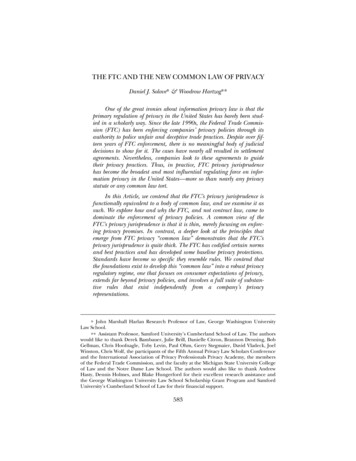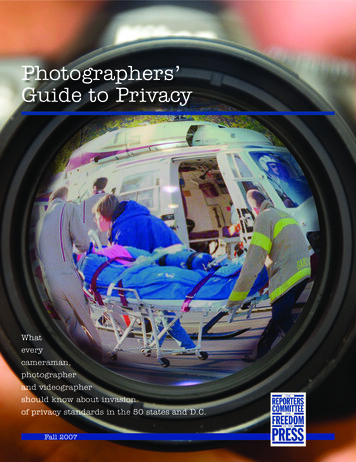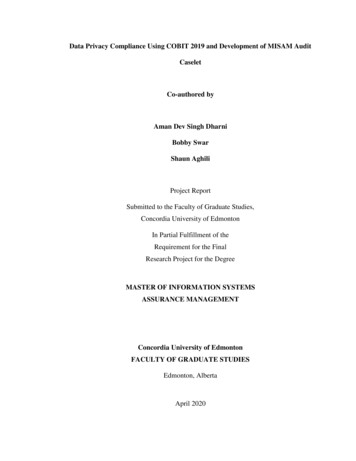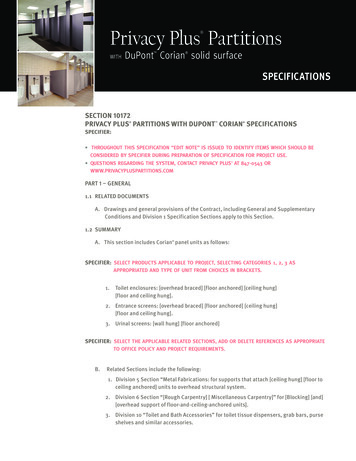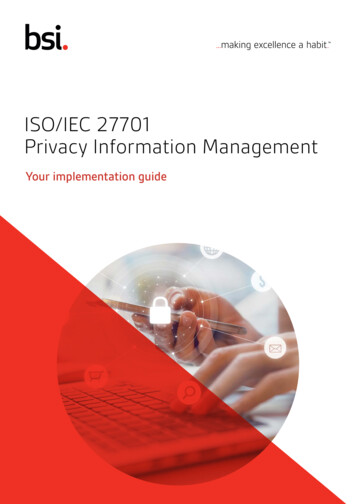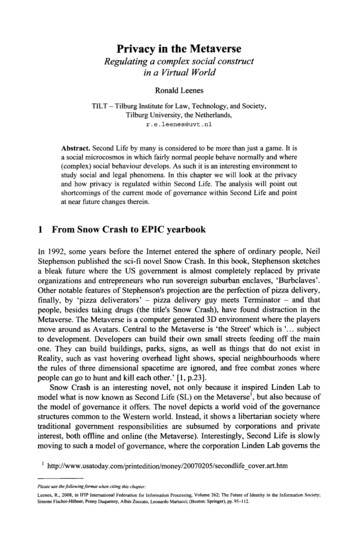
Transcription
Privacy in the MetaverseRegulating a complex social constructin a Virtual WorldRonald LeenesTILT - Tilburg Institute for Law, Technology, and Society,Tilburg University, the Netherlands,r.e.leenes@uvt.nlAbstract. Second Life by many is considered to be more than just a game. It isa social microcosmos in which fairly normal people behave normally and where(complex) social behaviour develops. As such it is an interesting environment tostudy social and legal phenomena. In this chapter we will look at the privacyand how privacy is regulated within Second Life. The analysis will point outshortcomings of the current mode of governance within Second Life and pointat near future changes therein.1 From Snow Crash to EPIC yearbookIn 1992, some years before the Internet entered the sphere of ordinary people, NeilStephenson published the sci-fi novel Snow Crash. In this book, Stephenson sketchesa bleak future where the US government is almost completely replaced by privateorganizations and entrepreneurs who run sovereign suburban enclaves, 'Burbclaves'.Other notable features of Stephenson's projection are the perfection of pizza delivery,finally, by 'pizza deliverators' - pizza delivery guy meets Terminator - and thatpeople, besides taking drugs (the title's Snow Crash), have found distraction in theMetaverse. The Metaverse is a computer generated 3D environment where the playersmove around as Avatars. Central to the Metaverse is 'the Street' which is ' . subjectto development. Developers can build their own small streets feeding off the mainone. They can build buildings, parks, signs, as well as things that do not exist inReality, such as vast hovering overhead light shows, special neighbourhoods wherethe rules of three dimensional spacetime are ignored, and free combat zones wherepeople can go to hunt and kill each other.' [1, p.23].Snow Crash is an interesting novel, not only because it inspired Linden Lab tomodel what is now known as Second Life (SL) on the Metaverse\ but also because ofthe model of governance it offers. The novel depicts a world void of the governancestructures common to the Western world. Instead, it shows a libertarian society wheretraditional government responsibilities are subsumed by corporations and privateinterest, both offline and online (the Metaverse). Interestingly, Second Life is slowlymoving to such a model of governance, where the corporation Linden Lab governs 7020S/secondlife cover.art.htmPlease use the followingformat when citing this chapter:Leenes, R., 2008, in IPIP International Federation for Information Processing, Volume 262; The Future of Identity in the Information Society;Simone Fischer-Hubner, Penny Duquenoy, Albin Zuccato, Leonardo Martucci; (Boston: Springer), pp. 95-112.
96Ronald Leeneswhole virtual world and a multitude of private entities will govern 'estates'. WhatStephenson introduced as a though experimenr in the book is in a sense the operatingmode of Second Life.Since 2003, Second Life has evolved into one of the popular massivelymultiplayer online role-playing games (MMORPGs), with at present some 11 millionResidents. 3 Contrary to many other MMORPGs, SL lacks a content-driven plot,enabling it to be used for a multitude of different purposes, such as a platform forsocial interaction, design, manufacture and delivery of objects and services, or just forexploring a 3D environment.Perhaps because SL lacks a plot and allows the Residents to define what SL is, theidea has been coined that SL could be perceived as a social microcosmos in which theplayers exhibit real(istic) social behaviour, which would potentially make it a uniqueresearch platform for the social sciences and clinical therapy [2]. This would offerinteresting opportunities, not only for the study of people's behaviour, but also for thestudy of social phenomena and for the experimentation with legal constructs andinstruments, including governance.Whether studying SL behaviour makes sense, and whether drawing conclusionsfrom the virtual world for the real world are valid, or even credible, depends on theextent to which social behavior and norms in SL are comparable to those in thephysical world [2]. I will argue that this is the case to some extent. I will do so byexploring some of the information available on the demographics of SL Residents andtheir behaviour. This includes data about more complex (automatic) social behaviour,such as maintaining interpersonal distance and gaze. The tentative conclusion that canbe drawn on the basis of this material is promising: there is congruency of socialnorms in Second Life and the real world.Given these results we can then move on to explore one of the more complexsocial needs, privacy, and explore how this is handled in a relatively novelenvironment. Because SL is relatively new, relatively anarchistic and highlymalleable, it could provide an ideal environment to study whether and how privacyevolves over time. Will privacy be regarded as an outdated social need, or will agenuine need for privacy in this brave new world arise? How do different forms ofgovernance affect privacy in the virtual world? Because the rules of the onlineenvironment are flexible, SL could be an ideal test bed to explore a social value suchas privacy [3]. EPIC and Privacy International have even gone as far as includeSecond Life as a jurisdiction in their annual privacy and human rights report 2006 [4].Privacy may seem an odd social construct to explore in an environment that isaimed at offering its user almost unlimited means to expose themselves. There areinworld (privacy) concerns, such as anonymity, reputation and control over who iswatching, and when [4]. These are not only 'game' concerns, but because of the factthat value is created within the game, valued in Linden , and that these L can be23See for instance the interview in Reason, February 2005, with the ttp://secondlife.comlwhatis/economLstats.php states that there are 11.234.792 as of 4December 2007, in the 7 days preceding this date, 332.904 Residents had logged into thevirtual world.
Privacy in the Metaverse97exchanged against US at the Linden Exchange (the LindeX), they also become realworld concerns. Furthermore, SL Residents not only have Second Lives but also RealLives. Inworld activities may have Real World ramifications. The interaction betweenSL and RL creates specific privacy issues. And to make the situation even morecomplex, the inworld perception of privacy issues are likely to be inspired by theperceived real-world implications of inworld actions. The inworldlreal-world borderis highly permeable. Given these issues, there may be a privacy need at least on thelevel of individuals. Whether the social value of privacy will be acknowledged is adifferent question.In this chapter we will look at SL as a social microcosmos, privacy issues andprivacy regulation in SL, how Residents and game creators (Linden Labs) handle (ormishandle) privacy and how the virtual world permeates the real world. Finally wewill look at the state of governance in the game and the outlooks for near futuregovernance and what this may mean for privacy as a social value.2 Microcosmos or just a game?Hiro Protagonist, Stephenson's hero in Snow Crash spends considerable time in theMetaverse. His business card reads "Last of the freelance hackers and the Greatestswordfighter in the world". Not your average person, and certainly when oneconsiders that his swordfighting is practiced in the Metaverse as well as in the realworld. What about Second Life's Residents? Who are they and what do they online?A rich data source on MMORPGs is Nick Yee's Daedalus project, which aims atcollecting empirical data about "the psychology of MMORPGs".4 The data reportedon in this project, as well as in similar studies, have to be taken with a grain of saltbecause they are prone to self-reporting and selection biases. Nevertheless, they areindicative for the demographics ofMMORPG-garners. For MMORPGs in general thecurrent statistics show the average age of players to be around 26, about a quarter ofthem being teenagers. About half of the players have a full-time job, slightly over athird is married and about a quarter have children. MMORPG players, on average,spend about half a working week (22 hours) playing their games, a number not relatedto their age. This would suggest MMORPG garners take their games very seriously.Most players (80%) play with someone they know in Real Life (RL) (a romanticpartner, family member, or friend).A large proportion of garners consider themselves to behave the sarne in the garneas in RL - 72% of the female garners versus 68.8% of the males, or even better thanin RL - 25.8% for the female and 31.8% for the males. This means that only a smallpercentage says to misbehave and lie online, which is contrary to popular opinion. 5Other interesting findings of Yee's studies are that many garners are very social andbefriend people they meet online. This is especially the case for the female garners, ofwhich some 75% report to have a few or a bunch online friends, while only ves/000193.php
98Ronald Leenes19% has no online friends. Male garners are more solitary; 33.8% report to have noonline friends or just one (7.2%). The distribution of a few and a bunch of friendsamong male garners resembles that of female garners, albeit that the overall jointpercentage is lower at 60%. More telling than the number of online friends is whethergarners consider their online friendships real in the sense that information that veryfew other people know is shared with friends. The female garners, unsurprisingly, tumout to be more social than the male garners. 52.9% of the female garners says to havereal deep friendships online. The males score much lower. Only 38.6% of themconsider their online friendship deep.Dutch studies conducted by EPN focus on SL players in the Netherlands. EPNconducted a survey in 2006 [5], when there were some 17.000 Dutch SL Residents,and in 2007 [25].6 The Dutch data corroborates the intensity of game play found inNick Vee's studies. More than half of the garners spend 18-30 hours a week (24%), oreven more than 30 hours per week (33%) in Second Life. The 2007 study shows aslight decrease in time spent on the game. Follow up in-depth interviews in 2006revealed that playing was real playing, and not just 'chair carnping' - being online andparking the avatar somewhere, while doing something else, such as watching tv, in themeantime. People play in breaks, evenings, and weekends, basically every freeminute. With respect to age distribution among the respondents, the 25-40 group ismost strongly represented (50%), while the 16-25 and over 40 groups are about equalin size.One of the frequent heard claims is that there are many gender experiments withinSL. In the 2006 EPN study, this turns out not to be the case for the female players.Female players claim to have female avatars, while only 1 (out of 246) claims to havea male avatar and 2 change their gender occasionally. Among the male players thesituation is slightly different. The large majority of male gamers has a male avatar(112), while 15 have a female avatar and 6 change their online gender occasionally.The conclusion here is therefore twofold. Firstly, the gender distribution in the sampleis about equal, and secondly, only 10% of the respondents conducts genderexperiments, men more than women.The educational level in 2006 was high, about half of the female respondents has auniversity degree or even a PhD. For the male players the level is slightly lower. The2007 study shows a more normalised picture, the overrepresentation of academics hasdropped from 48% to 38%. A remarkable finding is that the average income of theplayers is positively correlated to the amount of time garners spend online. In otherwords, heavy players have a higher average income. Here we find a large proportionof IT professionals and creative individuals. Students and public servants generallyspend less than 17 hours a week in Second Life.Based on this limited survey of demographic data we may conclude that thegarners take their games seriously and devote much energy to it. MMORPGs appearto be highly social environments where new relationships are forged and existingrelationships are reinforced. Although the game populations, both of MMORPGs in6The 2006 survey was conducted in August/September 2006 and involved 273 garners, ofwhich 246 completed the questionnaire. The 2007 study was conducted in the summer of2007 and comprised over 500 respondents.
Privacy in the Metaverse99general and SL in specific, are not representative, there also is not a clear bias towardsa particular gender, age, or educational group, apart from SLers by defmition beingover 18 years of age. Second Life Residents appear to be fairly normal people.2.1Inworld social behaviourSecond Life has no plot line, and therefore the Residents themselves define what SL isused for. One way of decomposing SL usage is by distinguishing between SL as agame environment and SL as a functional platform. Vee [6], building on Bartle,provides a comprehensive decomposition of the game aspects ofSL (see figure 1).Table 1. Motivations for gameplay as distinguished by Yee [6].achievementadvancementprogress, power,accumuluation, statusmechanicsnumbers, optimization,templating, analysiscompetitionchallenging others,provocation, dominationsocialsocializingcasual chat, helping others,making friendsrelationshippersonal, self-disclosure,find and give supportteamworkcollaboration, groups, groupachievementsimmersiondiscoveryexploration, lore, findinghidden thingsrole-playingstory line, character history,roles, fantasycustomizationappearance, accessories,style, color schemesescapismrelax, escape from RL,avoid RL problemsVee's study focuses on all MMORPGs and some motives, most notably themotives related to role playing and adventure, will be lacking in SL. According to theEPN studies [5, 25], having 'fun', which is undefined in the studies, followed by'doing things I can't do in real life' and social motives, such as meeting friends andlearning are the primary reasons to adopt a Second Life within the Dutch sample.Mapped onto Vee's ontology, most (Dutch) players have social (socializing,relationship) and/or immersion (discovery, customization, escapism, and a specifickind of role-playing) motives. An interesting observation is that 16 out of 246respondents indicated that they have a disability in the real world and that this is amotive for them to be in Second Life [5].Next to game playing, SL can also be used as a functional platform. In this casethe environment's rich audio-visual capabilities, as well as the possibility to havegroup meetings and group interactions are the main drivers. Uses that belong in thiscategory are inworld lectures, courses, and meetings. SL overcomes some of thedisadvantages of other computer mediated forms of online learning and onlinemeetings because of the richer visuals cues provided by the avatars as we will seebelow. SL is also used as a training environment for social interactions. For instance,
100Ronald Leenesthe Dutch Tax authorities have used SL as a training ground for company search andseizure operations. 7Social interaction in both major types of uses is important. But how realistic is thesocial behaviour exhibited in SL? One interesting anecdote regarding emerging socialnorms within the game relates to 'virtual laptops', animated laptops to be used withinthe game. Residents started taking these functional devices with them to inworld bars,restaurants and disco's and using them while within these (social) environments. 8 Thisbehaviour was seen as anti-social and a social norm, netiquette, emerged disproving it.As with all social norms, people have to learn the rules and they may be pointed out tonewcomers in blunt or subtle ways.But also on a deeper level inworld behaviour appears to be guided by real worldsocial norms. Vee et al. [2] studied social norms of gender, interpersonal distance(lPD), and eye gaze transfer in Second Life. They found that even though themodality of movement is entirely different (i.e., via keyboard and mouse as opposedto eyes and legs), that IPD and eye gaze in virtual environments is similar to that inthe real-world. Inworld, like in the real world male-male dyads stand further apartthan female-female dyads. Furthermore, male-male dyads maintain less eye contactthan female-female dyads, and finally, when the interpersonal distance between twoavatars decreases this is compensated by averted gaze, which is predicted by theArgyle's Equilibrium Theory. The results on gaze as an indicator for turn-taking isinteresting because this visual cue can help improve leT mediated meetings, whichare often plagued by inertia, multiple participants talking at the same time anddifficulties assessing who is talking to whom [7].Another interesting experiment relating to social behaviour in Second Life is thereplication of the famous Milgram experiments by Slater et al. [8]. In the originalMilgram experiments, people were instructed to inflict (apparently) lethal electricshocks to a stranger on the command of an authoritive figure. A staggering number ofpeople appeared to obey to these commands. The Slater replication [8] features thetest subjects to administer a series of word association memory tests to a femalevirtual human (the learner). When the learner gives a false answer the subject isinstructed to administer an 'electric shock' with increasing magnitude. The learnerresponds with increasing discomfort and protests. Even though the test subjects knewthat neither the learner nor the shocks were real, those who saw and heard the learner(23 out of 34) tended to respond to the situation at the subjective, behavioural andphysiological levels as if it were real. Their own discomfort with sounds and imagesof a (virtual) person in distress caused them to behave differently than people wholacked these signals.The experiments and research reported here do not provide a definite answer tothe question whether SL is to be taken as a real social microcosmos, but they doillustrate that people can immerse in virtual environments in a way that resemblestheir real world behaviour. This, according to Yee et al. 'has significant implicationsfor using virtual worlds to study human social interaction. If people behave according78Private communication during a lecture the author gave on SL on June 21, 2007.I am not making this up, people access SL on their laptops to play on virtual laptops. Wherewill this recursion stop?
Privacy in the Metaverse101to the same social rules in both physical and virtual worlds even though the mode ofmovement and navigation is entirely different (i.e., using keyboard and mouse asopposed to bodies and legs), then this means it is possible to study social interactionin virtual environments and generalize them to social interaction in the real world.'[2].3 Privacy - past tense?Social interaction is an important motive for people to assume a Second Life. Socialinteraction involves sharing information with others. Yet information sharing is notunconditional. People have a need to control who has access to what information andthey need to be able to play different roles in different arenas. Audience segregation[8] is an essential part of everyday life. Does this also hold for Second Live?On first sight, Second Life seems to be based on openness and transparency assome of the default settings in the game illustrate.The players move their avatars around in a 3-D environment and the scene isobserved by the player who can take either a first person perspective (called mouselook in SL) and look through the eyes of their avatars, or a third person perspectivewhere the camera is detached from the avatar allowing the player to watch both theirown avatar as well as the environment. In third person perspective, which is thedefault in SL, the camera can move independently of the avatar and can be taken tolocations different from the avatar's. This practically allows the player to use thecamera as a spying device to unobtrusively observe other avatars and theirinteractions. The camem can even be attached to another avatar without this avatar'sawareness. This act comprises virtual stalking. Especially the third person view allowsthe player to observe much more of their avatar's environment than is the case in thereal world which may also infringe on other's privacy because they may be unawareof the observation.Another difference with the real world is that moving about anonymously is moredifficult. Although players can easily, and mdically, adapt the appearance of theiravatars to make it difficult or even impossible to recognize them, this does not reallyhelp, because the avatar's name is clearly visible; by default it hovers above theavatar.Not only the Resident's name provides information about them. One can also findout more about a particular Resident by inspecting their profile. This can either bedone by right-clicking on the avatar, or from within the search function. In the lattercase the Resident in question needs not be in the vicinity, but their name is sufficientto pull up their profile. The profile reveals what the Resident wants to reveal abouttheir identity. It contains sections about the Resident's 2nd Life - including photo,date of birth, partner, group memberships, and a 500 char description of the Resident-, websites of interest, inworld interests, and 1st life, where one can provideinformation about one's real world identity. Many Residents only provide sparseinformation, especially about their RL identity, but the amount of informationavailable up for grabs surpasses that in RL easily.
102Ronald LeenesIn default mode it is also difficult to keep the location of one's Resident hiddenfrom others. The game features an extensive directory that allows any nameable itemto be found. Residents and places can be found by entering partial names or words.The location of the item requested can be shown on the map, and the Resident can beteleported right to it. The search results also show whether a requested Resident isonline. Residents can keep a list of their inworld friends. This SL address book willalso show whether friends are online.The basic mode of communication in SL is by means of typed text; voice supporthas only recently been introduced in the game. Residents can either chat to otherResidents, or use instant messages. In chat mode, the communication of everyResident within a radius of about 20 meters is visible to the player. This means thatResidents can listen in on the communication between other nearby Residents, muchlike in the real world. Instant messaging resembles RL phone conversations. These aremore private and don't require the recipient to be anywhere near.3.1Regaining privacyThe preceding section illustrated that, in default mode, SL Residents can learn muchabout their fellow Residents and their interaction by using the tools provided by thegaming environment. In practice the players have control over the personal data thatgets disclosed to other gamers. Furthermore, privacy provisions are also included inthe game's regulatory framework, the Terms of Service (ToS) and the CommunityStandards (CS), which are enforced by Linden Lab. Linden Lab's Privacy Policy,finally, outlines the way in which Linden handles the user's personal data.Privacy comes into playas soon as a individual emolls in the game. Duringregistration, the user has to choose a name for their avatar, comprised of a freelychosen first name and a surname to be selected from a list of predefined surnames.Article 2.1 of the ToS requires the user to provide accurate information about theirreal name, gender, date of birth, and country of residence during registration. Becausethe user enters into a contract with Linden Lab during registration, article 2.1 of theToS is binding. The information entered during registration is only available toLinden Lab, unless the user discloses it to other Residents in conversation or includesit in their profile (under the 1st life tab). If a user wants to own land, then additionaldata has to be provided during registration. This includes payment data (credit carddata or PayPal data). In this case also an age check is performed.Once a user has created a primary avatar, they can also create Alternate accounts,or Alts. These Alts allow a user to engage in the game under a different identity andtherefore allow users to segregate audiences. They can go to one island as theirnormal avatar and switch to an Alt when visiting another. The different identities areunlinkable for the Residents, but Linden can make the connection between the variousidentities belonging to a particular user account. Alt accounts are used for variousreasons. They offer a kind of anonymity and are therefore popular among users whowant to misbehave, for instance because they want to grief other Residents (inworldthis means making other Residents' SL miserable by acts such as trolling, flaming,and spamming). Linden Lab reports [10] that the number of abuse reports has not
Privacy in the Metaverse103increased since the option to create Alts was opened for users with basic unverifiable - accounts. Audience segregation is also a genuine need for normal users.IBM has a significant presence in Second Life. Their employees with a Second Lifedo not always want to be associated with the company or be recognizable as IBMemployees, and therefore many of them have Alts for private purposes. The 2007 EPNstudy [25] shows that the Dutch respondents on average have 1.6 avatar, althoughalmost three quarters only has one avatar [25].The user can change user preferences that affect data disclosure and the Resident'sprivacy. For instance, users can toggle whether their name is visible to otherResidents, whether their profile shows up in search, and whether their online status isvisible to friends. It is also possible to manipulate the avatar's status, for instance bysetting their status to offline while being online, or by setting it to busy, bothsuggesting unavailability of the avatar.Linden on their support pages [12] state that users can create their own privateislands, also called private estates, where they have control over who can get to theisland by teleporting (which is the principal way to get to an island). The privateislands therefore are really enclaves where only the 'happy few' can go and whichtherefore offer a maximum level of privacy. A final option for gaining some privacy iscreating a skybox [12]. A skybox is a private home that lives up high in the sky andthat can only be reached by avatars equipped with flight assist scripts. This does notseem to be a very relevant or serious way to get some privacy in SL, but nevertheless.3.2Privacy infringementsIn principle real world privacy breaches have their counterpart in SL due to the factthat Second Life resembles real life. People are curious and nosy in SL as they are inRL. Whenever Residents are interacting, by text or voice chat, there will also beResidents around that can listen in on the conversation and based on what they hear orsee conclude that they want to know more. The various tools outlined earlier allowthem to do so. The knowledge that can be acquired by listening in on conversationswill often be confined to inworld knowledge. Judging from my own experience, manypeople use SL as a virtual market square where conversations will cross the SLIRLborder. Many people are (also) interested in other Resident's real lives. The distinctionbetween SL and RL easily blurs. And hence information about a Resident's 1st lifecan often also be obtained easily. From here, Google helps to fill in the blanks.Inworld, people's curiosity can also be satisfied by calling virtual detectiveagencies to help. Famous inworld detective agencies are those run by MarkieMacDonald's respectively Bruno Buckenburger [14]. Like in the real world, thesedetectives are employed for various covert operations, including surveillance andspying on people. Well known examples of their line of work are 'honey pot'operations to uncover inworld infidelity.Residents have inworld relations and also the concept of marriage exists in SecondLife, which includes a commitment not to be unfaithful. So, there are Residents whowant to know whether their partner is unfaithful. Hamlet Linden [14] reports of thecase of Laura Skye who hired Markie MacDonald to set up a honey trap, involving a
104Ronald Leenesgorgeous woman or a handsome man hired to approach the target of an infidelityinvestigation, lay down some seductive pattern on him or her, and see if the suspectedphilanderer takes the bait. This clearly invades the private sphere of the Residentbeing investigated. It would be easy to consider this kind of behaviour as part of thegame or as confined to the game, but it goes beyond this. As the following section ofHamlet Linden's interview with Laura Skye, who happens to have a relation with the'suspect' in real life as well as in SL, illustrates:"If you had found out he was cheating on you in Second Life," Iask her, "how would that effect your real life relationship?""It would be the end of the relationship.""You would break up with him in real life?""Oh yes." [14]An interesting question is whether the activities of the private detectives are legal(within the game). Article 5.1 sub ii of the Terms of Service state:"[You shall not] impersonate any person or entity, including, but not limited to,a Linden employee, or falsely state or otherwise misrepresent your affiliation witha person or entity."The target of covert oper
environment. Because SL is relatively new, relatively anarchistic and highly malleable, it could provide an ideal environment to study whether and how privacy evolves over time. Will privacy be regarded as an outdated social need, or will a genuine need for privacy in this brave new world arise? How do different forms of

